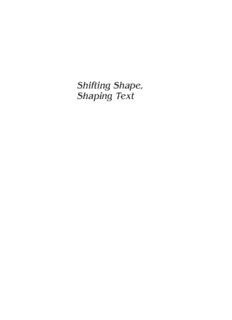Table Of ContentShifting Shape,
Shaping Text
Shifting Shape,
Shaping Text
Philosophy and Folklore
in the Fox Kòan
Steven Heine
University of Hawai‘i Press
HONOLULU
©1999UniversityofHawai‘iPress
Allrightsreserved
PrintedintheUnitedStatesofAmerica
040302010099 54321
LibraryofCongressCataloging-in-PublicationData
Heine,Steven1950–
Shiftingshape,shapingtext:philosophyandfolkloreintheFoxkòan
/StevenHeine.
p. cm.
Includesbibliographicalreferencesandindex.
ISBN0–8248–2150–5(alk.paper).—ISBN0–8248–2197–1(paper:
alk.paper)
1.Koan. 2.Hui-hai,720–814. 3.Zenmeditations. 4.Zen
Buddhism—Folklore. 5.Karma. I.Title.
BQ9289.5.H44 1999
294.3(cid:1)927—dc21 99–24368
CIP
UniversityofHawai‘iPressbooksareprintedonacid-free
paperandmeettheguidelinesforpermanenceand
durabilityoftheCouncilonLibraryResources.
DesignedbyNortheasternGraphicServices,Inc.
PrintedbyTheMaple-VailBookManufacturingGroup
Contents
Preface vii
Abbreviations xi
Part One: Shape-Shifting
1.PuttingtheFoxBackintheFoxKòan 3
2.TheKòan’sMultivalentDiscursiveStructure 41
Part Two: Text-Shaping
3.PhilosophicalParadigmofParadoxicality 67
4.DeepFaithinCausality 105
5.FolkloreMorphologyandtheIssueofRepentance 131
6.UnconcludingMethodologicalReflections 177
AppendixI:TranslationsofFoxKòanCommentaries 201
AppendixII:Translationof“Pai-chang’sMonasticRules” 217
Notes 223
ListofSino-JapaneseTerms 261
Bibliography 000
Index 000
v
Preface
Ittakesafoxtoknowafox.
—Ts’ung-junglu,case24
T
his book draws on my fascination with the complex vari-
etiesandmultiplemeaningsoftheshape-shiftingwildfox—asymbolof
liminality in East Asian folklore—in order to analyze the theory and
practiceofCh’an/ZenBuddhisminitsformativeperiodinChinaandJa-
pan.ThebookdevelopsawiderangeofimplicationsaboutearlyZenby
examiningaspecificexampleofthekòantraditionknownas“Pai-chang
(J.Hyakujò)andthewildfox”or“Pai-chang’swildfoxkòan,”whichisin-
cludedasthesecondcaseintheWu-menkuanandnumerousothercol-
lections. While most interpretations comment on the philosophy of
causality,myaimistoshowhowthefoxkòandealswiththedoctrineof
karma in terms of a generally overlooked folklore narrative of fox-spirit
possession and exorcism borrowed from Buddhist morality tale litera-
ture(oftenlabeledsetsuwabungaku).Thekòanthusservesasalensfor
examining the intersection in Zen of philosophical discussions on
cause-and-effectandpopularreligiousapproachestokarmicretribution
andrelease.Therelationbetweentheseinterlockingdiscursiveperspec-
tivesisdiscussedinlightoftheimageofMasterPai-changasastrictdis-
ciplinarian who advocates an ethic of “no work, no food”—an ethic
reflectedinhismonasticrulestext,theCh’an-menkuei-shih(J.Zenmon
vii
viii • Preface
kishiki),whichalsostressestheneedtobanishrogueormiscreantmem-
bers of the saºgha.
Thusthebookdealswiththerelationbetweenatriadofissues:aphilo-
sophicaldebateabouttheparadoxicalidentityofcausalityanditsantithe-
sis noncausality; a folkloric expression of retribution and repentance
conveyed by the kòan’s exorcism narrative; and Pai-chang’s monastic
rulesandrecordedsayingstexts.ThebookdemonstratesthatPai-chang’s
rulesandrecordsarticulateasenseofmonasticorderandmoralstability
that combats the criticism of Buddhism as an antinomian, antisocial,
“wildfox”religiouslifestyleinawaythatdovetailswiththeritualelimina-
tionofanintrudingvulpinespiritthatisperformedinthekòanrecord.
Chapter1introducesthetextandcontextofthefoxkòanandevaluates
Zen’sambiguous(orduplicitous)attitudeaboutsupernaturalbeliefsand
diverseusesoftherhetoricofthewildfox—eitherasacriticismofrogue
monks who violate rules or as praise of morally superior patriarchs who
transcendtheneedforregulations.Thischapteranalyzesvariouskindsof
syncretism incorporating indigenous fox-cult worship that encompasses
the poles of the fox portrayed as positive/protective and as negative/de-
structive—evenwhileZenrhetoriccloaksitselfinanauraoficonoclastic
repudiationofanimism.Chapter2exploresthemethodological issueof
examining the connection between philosophy and folklore while at-
temptingtoovercometheconventionaltwo-tieredmodelofgreatandlit-
tle traditions. The underlying theme in the examination of ambivalent
approachestothefundamentallybivalentvulpineimageryinPartOneis
that fox transfiguration represents the crossing of boundaries and the
possibilityofconqueringillusionduringtimesoftransitionandtransfor-
mation—especially in moral crises when conventional reality is chal-
lenged, undermined, or otherwise called into question. Throughout the
booktherearecitationsofliteraryandartisticexpressionsoffoxfolklore
inrelationtoZenthought.
InPartTwo,Chapter3focusesonphilosophicalinterpretationsofthe
doctrine of causality and explores the debate between a literal reading
of the kòan, which emphasizes a strict adherence to the law of karma,
and the mainstream paradoxical reading, which embraces an identity of
causality and noncausality. Chapter 4 deals extensively with the contra-
dictory interpretations of the fox kòan presented in two fascicles of
Dògen’s Shòbògenzò and related writings. It also considers the contro-
versy in contemporary scholarship, particularly Critical Buddhism,
about whether it is possible to appropriate Dògen’s apparent change of
Preface • ix
heart—expressed in an exclusive emphasis on the literal reading of the
kòan in his later period—to illumine socioethical problems in Bud-
dhism’s interaction with modern society. Chapter 5, citing examples of
fox folklore from a variety of setsuwa sources, shows that one must un-
derstand how folklore motifs provide a literary and conceptual under-
pinning of the fox kòan’s approach to the experience of repentance if
oneistointerpretthephilosophicallevelofthecase.Chapter6returns
to the hermeneutic issue of overcoming the two-tiered model. In this
chapterIassessrecentattemptsbyleadingscholarstodealwiththerole
ofpopularreligionsintheZentraditionandthenproposeanalternative
model based on a theory of intertextuality—that is, the interconnected-
ness of diverse textual materials.
The appendixes contain two sets of translations. Appendix I presents
thestandardWu-menkuaneditionandanalternativeearlyeditionofthe
fox kòan from the T’ien-sheng kuang-teng lu, including a detailed com-
parison of the two versions, as well as the edition of the kòan in the
Ts’ung-junglukòancollectionandtwoversescontainedinDògen’sEihei
kòrokujukocollection.AppendixIIpresentsatranslationofPai-chang’s
rules,theCh’an-menkuei-shih,whichwasfirstincludedasanappendix
tothebiographyofPai-changintheChing-tech’uan-tenglu(“transmis-
sion of the lamp” text) of 1004. Additional translations of prose and po-
eticcommentariesonthekòanappearthroughoutthebook.
Acknowledgments
Themajorsourceoffundingfortheresearchforthisbookwasafellow-
ship awarded by the National Endowment of the Humanities
(1996–1997). Other funding sources include Florida International Uni-
versity DSRT funding (1997–1998), the Northeast Asia Council of the
AssociationforAsianStudies(1996),theAmericanAcademyofReligion
(1996), the Pennsylvania State University Liberal Arts Research and
GraduateStudiesOffice(1994and1996)aswellastheInstituteforArts
and Humanistic Studies (1995), the Indiana University East Asian
Studies Program (1995), and the University of Chicago East Asian
StudiesProgram(1996).
Some of the material first appeared in “Putting the ‘Fox’ Back in the
‘Wild Fox Kòan’: The Intersection of Philosophical and Popular Reli-
gious Elements in the Ch’an/Zen Kòan Tradition,” Harvard Journal of
Asiatic Studies 56(2) (1996):257–317. Additional material was incorpo-
x • Preface
rated from the following two articles: “Sòtò Zen and the Inari Cult:
Symbiotic and Exorcistic Trends in Buddhist–Folk Religious Amalgam-
ations,” Pacific World 10 (1994):71–95; and “Critical Buddhism (Hihan
Bukkyò) and the Debate Concerning the 12-Fascicle and 75-Fascicle
Shòbògenzò Texts,” Japanese Journal of Religious Studies 21(1)
(1994):37–72. Various versions of the paper on the fox kòan were pre-
sented at the Harvard University Buddhist Studies Forum (1994), the
American Academy of Religion’s annual national meeting (1994) and
Mid-Atlanticannualregionalmeeting(1996),theFuseLectureSeriesof
theUniversityofTokyoDepartmentofIndianandBuddhistPhilosophy
(1996),thePrincetonUniversityEastAsianStudiesDepartment(1997),
and the Miami-Dade CC Honors Program (1998). I thank Yoshizu
YoshihideandIshiiShûdòofKomazawaUniversityandSuekiFumihiko
ofTokyoUniversityforhelpfuladviceandsuggestionsthatguidedmyre-
searchinZentheoriesandpractices.ThanksalsotoPatriciaCrosbyand
the staff of University of Hawai‘i Press for their support. Special thanks
alsotoDavidOlson,SohoMachida,DaleWright,BernardFaure,Jackie
Stone,andKarenSmyers,amongotherfoxyfriends.
Figures11and12showinginscribedstonesfromPai-chang’stemplein
KiangsiprovinceinChina—includingwhatissaidtobetheoriginal“wild
fox rock” where the discovery of the vulpine corpse and funeral took
place according to the kòan narrative—are presented courtesy of Ishii
Shûdò.ThanksalsotoStephenAddissforpermissiontoreprinttwopho-
tos(Figures2and14)fromhiscollectionandtotheIdemitsuMuseumof
ArtforFigure1.
Notes on Transliteration
Thisbookusestheterm“Zen”torefertobothCh’anBuddhisminChina
andZenBuddhisminJapan(exceptinquotationsfromscholarswhodo
otherwise).Wade-Gilesromanizationisusedthroughoutthebook,again
with the exception of quotations from scholars who use pinyin. Asian
names are given family name first, except in instances that cite an au-
thor’sworksinEnglish.
Description:According to the "Fox Koan", the second case in the "Wu-men Kuan Koan" collection, Zen master Pai-chang encounters a fox who claims to be a former abbot punished through endless reincarnations for denying the efficacy of karmic causality. Most traditional interpretations of the "Koan" focus on the p

